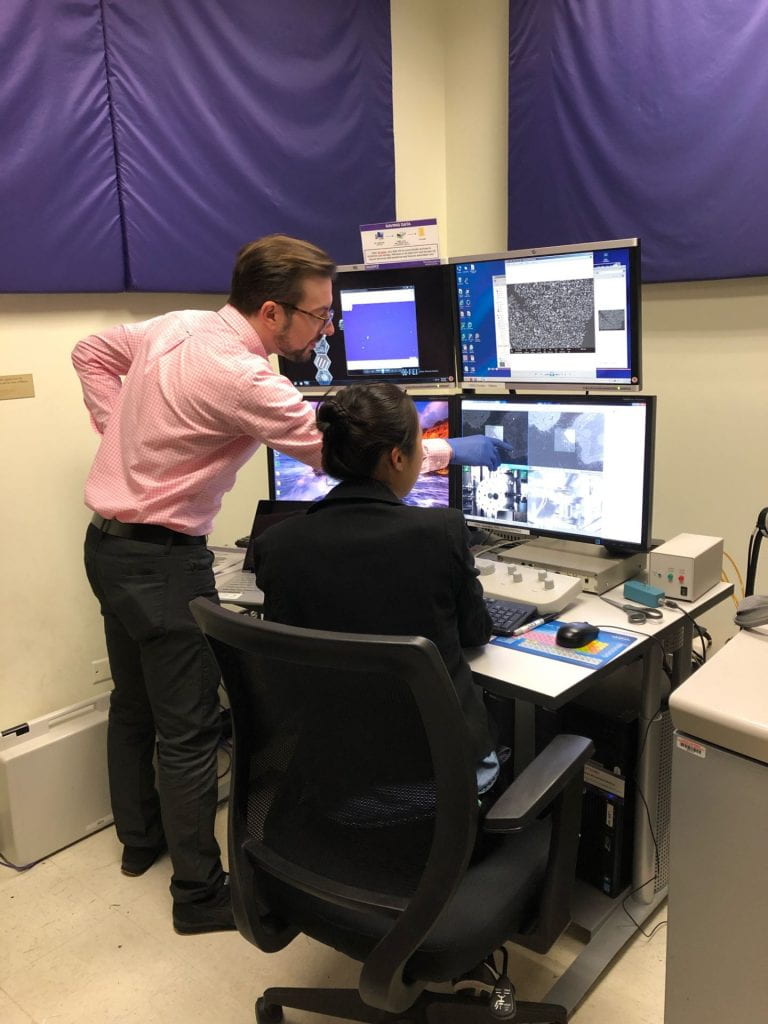SHyNE is excited to once again host a group of undergraduates as part of the Materials Research Science and Engineering Center’s Summer Research Experience for Undergraduates program!
Thirty faculty members from seven different departments are involved in the nine-week program, which is designed to allow undergraduate students to experience and participate in an interdisciplinary research project involving multi-functional nanoscale material structures. Students participate in research group meetings, go on field trips to national or industrial labs, attend a panel on graduate school admissions and attend seminars by Northwestern faculty and grad students. At the end of the program, each student writes a technical paper and gives a 15-minute oral presentation at a public symposium.
Learn more about the students SHyNE is hosting below:
Denise Hernandez
Rising junior at Claremont McKenna College
“Synthesis of SnO2/SiO2 Composites as high capacity anode materials for Lithium-ion Batteries”
Denise’s summer project involves optimizing synthesis of metal oxide composites for battery applications. The project will primarily involve tweaking various parameters in the synthesis process in order to obtain the desired nano-composite, followed by characterization of the composite’s composition and morphology via X-ray diffraction and SEM imaging.
Denise decided to attend the program to get experience with research outside of fields/projects she’d previously been involved in.
“I wanted to be immersed in an environment that was highly collaborative and interdisciplinary — both of which are emphasized in this program,” she said. “Ultimately, I am hoping to get an experience that will help me grow as a young scientist, and perhaps be a preview for the type of work that I would like to pursue in the future.”
Vivian Shi
Rising junior, Bard College at Simon’s Rock
“Optimization of Large Scale Imaging with Scanning Electron Microscopy”
Large-scale imaging techniques performed with a scanning electron microscope (SEM) can provide detailed images at magnification ranges that bridge the gap between light microscopy and transmission electron microscopy (TEM). Objectively determined SEM image quality will be optimized based on the instrumental parameters of acceleration voltage, spot size, and dwell time of the electron beam, as well as the working distance from the sample.
Vivian had her first experience with academic research and nanotechnology as an intern at Boston University last summer. She wanted to further explore her interest in the field via MRSEC’s REU program.
“I’ve already learned so much from my mentor, Eric Roth, about communication and presentation in addition to the many technical skills required for my project,” she said, adding that she’s not looking forward to the nine-week program’s inevitable end.
Connor Horn
Rising senior at Cornell University
“Heterostructural Growth of Potential p-Type Transparent Conducting Oxide CuAlO2”
Connor is using Pulsed Laser deposition to grow epitaxial single crystals on substrates with different crystal structures to those that are being deposited. This allows us to synthesize crystals that previously could not be grown before such as CuAlO2 which has potentially unique electronic properties as a transparent p-type semiconductor.
Connor found out about the REU program through the National Science Foundation’s website.
“I knew I was interested in nanotechnology and Northwestern has a great reputation for pioneering this kind of research,” he said.
Connor has previously done research at two high energy synchrotron radiation facilities and likes that the REU program allows him to build on that experience in an engaging, hands-on way.
Ryan Mbagna Nanko
Rising junior at the University of Maryland
“Structural Characterization of 2D Layered Complex Hetero-Ion Systems”
My project will focus on the structural exploration of novel 2-D layered systems with complex hetero-ion structures, such as metal chalcophosphates, atomic force microscopy (AFM), and Raman spectroscopy. By quantifying and analyzing recorded data, I aim to correlate the observed emerging properties with the structure of such materials by investigating them at the atomic level.
Ryan also said that Northwestern stood out because of the school’s great investment of resources in the fields of engineering and nanotechnology. He has enjoyed working with cutting-edge microscopy instruments and his mentor, Matthew Cheng, who he said “has been very welcoming and a great resource.”
“I have also enjoyed the structure of SHyNE in terms having weekly assignments geared to achieve better understanding of our individual project, as well as being able to present it at Cornell University,” he said.
